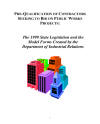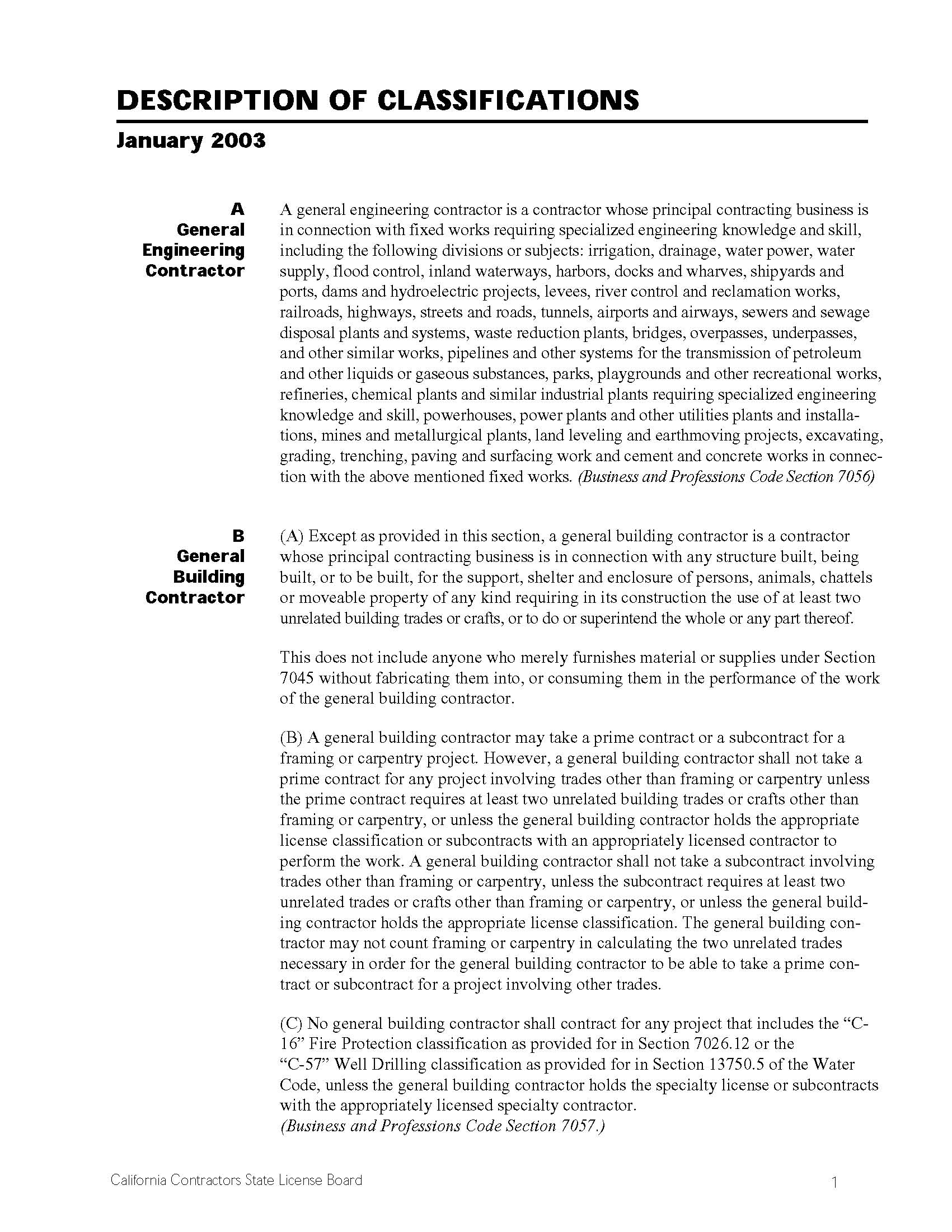|
LINKS
American Society of Civil Engineers
National Society of Professional Engineers
American Public Works Association
American Public Transit Association
American Planning Association
Ca Board of Professional Engineers & Land Surveyor
League of California Cities CITYLINK 2000
California State Association of Counties
U.S. Department of Transportation
Caltrans
Office of Statewide Health Planning & Development
Engineering News Record
Institute of Transportation Engineers
National Association of Housing and Redevelopment
Officials
Consulting Engineers and Land Surveyors of California
International
Conference of Building Officials (ICBO)
FORMS AND DEFINITIONS
DIG-Alert -
Word document or
PDF
document.
CA Contractors Mechanics Lien:
OVERVIEW
A Mechanics' Lien is an effective remedy for contractors, subcontractors,
and others involved in the construction or improvement of real estate to resolve
payment problems. If a service or materials provider records a Mechanics' Lien
against the real estate being improved, the owner can not easily sell or
refinance the property without first paying off the debt secured by the lien. A
Mechanics' Lien motivates the owner to make sure the contractors get paid, and
is a prerequisite to filing a foreclosure action on the property.
Preliminary Notices
Claimants who do not have a direct contractual relationship with the owner
(e.g., subcontractors) must provide a Preliminary Notice within 20 days of
furnishing labor or materials to the job. This ensures that the owner is aware
of a potential claimant, so that appropriate steps can be taken to confirm that
the contractor is paid. Preliminary Notices must be provided to the owner,
general contractor, and lender.
Click here for a California
Preliminary Notice form.
Mechanics' Liens
Mechanics' Liens are available to almost anyone who contributes labor,
services, or materials to a real estate improvement project. A Mechanics' Lien
is used to exact payment out of the real estate itself by placing a lien on the
property, making it difficult for the owner to sell or refinance the property,
and if necessary, allowing the lien holder to go to court to have the property
sold at auction.
Click here for a CA Claim of Mechanics'
Lien form.
Stop Notices
A Stop Notice attaches to the owner's undisbursed construction funds, rather
than to the property itself, as is the case in a Mechanics' Lien. A Stop Notice
compels the owner or lender to hold the remaining construction funds so that
claimants can recover for work already completed. Stop notices are not available
to claimants with a direct contractual relationship with the owner.
Click here for a CA Stop Notice form.
Removing a Lien or Stop Notice
Once a Mechanics' Lien has been recorded, the claimant must file a court
action to enforce the lien within 90 days. If no court action is filed by that
time, the lien is no longer valid. However, many title companies don't recognize
this fact, and require that the lien be removed before you can pass clear title
to a buyer. The easiest way to clear this lien is to ask the lienholder to file
a Release of Lien. If they will not, you can petition the court to release the
property from the Mechanics' Lien.
CA Contractors Mechanics Lien
Release
Click here for a CA Release a Lien form
Click here for a CA
Release of Stop Notice form
Click here for a CA Petition to Release a
Lien form
Prequalification of Contractors
Seeking to Bid on Public Works Projects
(Download the document)

California Contractors Description
of Classifications 2003
(Download the document)

California Water Environment
Association

Davis-Bacon Wage Determinations

State Water Resources Control Board (SWRCB)

Storm Water Pollution
Prevention Plan (SWPPP)
(Download the documents)
 Sample
Project SWPPP Specification Section 01820 Sample
Project SWPPP Specification Section 01820
 SWRCB
Notice of Intent (NOI) Forms SWRCB
Notice of Intent (NOI) Forms
BMP's Best Management Practices
(Download the documents)
 SWPPP
Best Management Practices SWPPP
Best Management Practices
 CALTRANS
Best Management Practices CALTRANS
Best Management Practices
Be patient, these two files take a few
moments to load.
National Pollutant Discharge
Elimination System (NPDES)
(Visit the EPA web site)

Traffic Control Plans
(Download the documents)
 Traffic
Control Plan - 3 Page Brief Traffic
Control Plan - 3 Page Brief
 CalTrans
Traffic Control Manual CalTrans
Traffic Control Manual
Operating Engineers Job
Description
(Download the documents)
 Heavy
Equipment Operating Engineers Job Description Heavy
Equipment Operating Engineers Job Description
|
                 
      |
|
Concrete Material Reference
Weight of Concrete - Pocket
Reference
How heavy is Concrete per cubic
foot?
The weight of Concrete depends on the aggregate.
Asphaltic concrete, 140 lbs/cubic foot,
Gravel concrete, 150,
Baryte aggregate (heavy, concrete with metallic aggregate) 200,
Lightweight concrete with expanded clay aggregate, 68,
Limestone aggregate concrete with Portland cement, 148.
From Thomas J. Glover Pocket Ref Third Edition 1989-2002.
What is the difference between
cement and concrete?
Although the terms cement
and concrete often are used interchangeably, cement is actually an ingredient of
concrete. Concrete is basically a mixture of aggregates and paste. The
aggregates are sand and gravel or crushed stone; the paste is water and portland
cement. Concrete gets stronger as it gets older. Portland cement is not a brand
name, but the generic term for the type of cement used in virtually all
concrete, just as stainless is a type of steel and sterling a type of silver.
Cement comprises from 10 to 15 percent of the concrete mix, by volume. Through a
process called hydration, the cement and water harden and bind the aggregates
into a rocklike mass. This hardening process continues for years meaning that
concrete gets stronger as it gets older.
So, there is no such thing as a cement sidewalk, or a cement mixer; the proper
terms are concrete sidewalk and concrete mixer.
How is Portland cement
made?
Materials that contain
appropriate amounts of calcium compounds, silica, alumina and iron oxide are
crushed and screened and placed in a rotating cement kiln. Ingredients used in
this process are typically materials such as limestone, marl, shale, iron ore,
clay, and fly ash.
The kiln resembles a large horizontal pipe with a diameter of 10 to 15 feet (3
to 4.1 meters) and a length of 300 feet (90 meters) or more. One end is raised
slightly. The raw mix is placed in the high end and as the kiln rotates the
materials move slowly toward the lower end. Flame jets are at the lower end and
all the materials in the kiln are heated to high temperatures that range between
2700 and 3000 Fahrenheit (1480 and 1650 Celsius). This high heat drives off, or
calcines, the chemically combined water and carbon dioxide from the raw
materials and forms new compounds (tricalcium silicate, dicalcium silicate,
tricalcium aluminate and tetracalcium aluminoferrite). For each ton of material
that goes into the feed end of the kiln, two thirds of a ton the comes out the
discharge end, called clinker. This clinker is in the form of marble sized
pellets. The clinker is very finely ground to produce portland cement. A small
amount of gypsum is added during the grinding process to control the cement's
set or rate of hardening.
What does it mean to "cure"
concrete?
Curing is one of the most
important steps in concrete construction, because proper curing greatly
increases concrete strength and durability. Concrete hardens as a result of
hydration: the chemical reaction between cement and water. However, hydration
occurs only if water is available and if the concrete's temperature stays within
a suitable range. During the curing period-from five to seven days after
placement for conventional concrete-the concrete surface needs to be kept moist
to permit the hydration process. new concrete can be wet with soaking hoses,
sprinklers or covered with wet burlap, or can be coated with commercially
available curing compounds, which seal in moisture.
Can it be too hot or too
cold to place new concrete?
Temperature extremes make
it difficult to properly cure concrete. On hot days, too much water is lost by
evaporation from newly placed concrete. If the temperature drops too close to
freezing, hydration slows to nearly a standstill. Under these conditions,
concrete ceases to gain strength and other desirable properties. In general, the
temperature of new concrete should not be allowed to fall below 50 Fahrenheit
(10 Celsius) during the curing period.
What is air-entrained
concrete?
Air-entrained concrete
contains billions of microscopic air cells per cubic foot. These air pockets
relieve internal pressure on the concrete by providing tiny chambers for water
to expand into when it freezes. Air-entrained concrete is produced through the
use of air-entraining Portland cement, or by the introduction of air-entraining
agents, under careful engineering supervision as the concrete is mixed on the
job. The amount of entrained air is usually between 4 percent and 7 percent of
the volume of the concrete, but may be varied as required by special conditions.
|






























